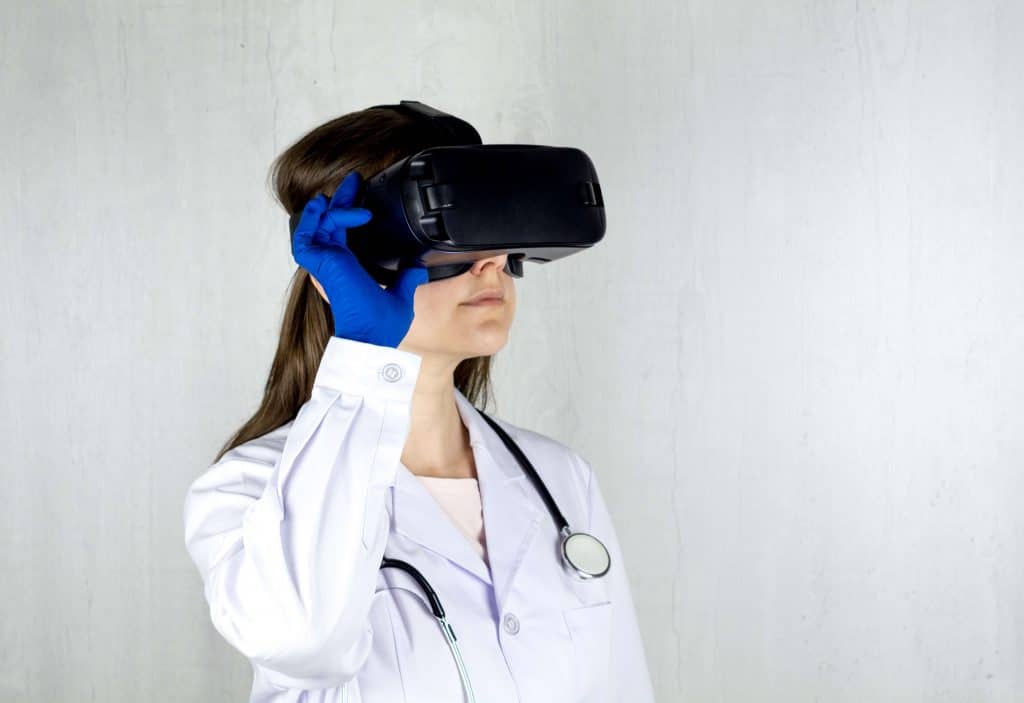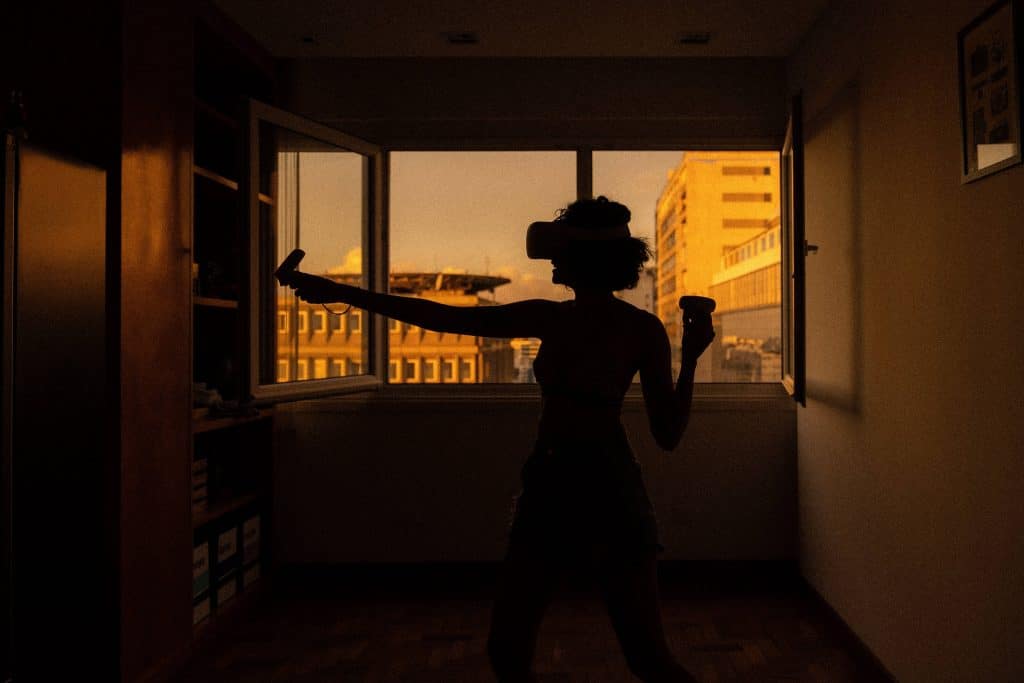
In 1935, a short sci-fi story called Pygmalion’s Spectacles talked about glasses that let you see an artificial, immersive reality where you get to be the protagonist. Sounds familiar?
After a century of engineering and fantasizing, in 2012, an 18-year-old entrepreneur Palmer Luckey presented the design for Oculus Rift. Now, with 5G on its way to speed up all our connected tech, we get to step into artificial realities and use them to improve our own.
Read the latest virtual reality statistics to see how VR is doing in the real world and learn about its use in the fields of education, medicine, business, and of course, arts and entertainment.
Top Virtual Reality Statistics (Editor’s Choice)
- The global virtual reality market in 2021 is estimated at $21.83 billion.
- In the US, 58.9 million people will use VR at least once per month in 2021.
- The educational VR market size is projected to reach $13 billion by 2026.
- 29% of US gamers owned a VR device in 2020.
- 68% of VR experts expect new immersive tech to improve surgical training.
- VR-trained learners are 275% more confident in applying their newly acquired knowledge.
- By 2030, VR will contribute $450.5 billion to the global economy.
- VR and AR are expected to create 23.4 million new jobs worldwide by 2030.
Essential Virtual Reality Facts for 2021
1. In the US, 58.9 million people will use VR at least once per month in 2021.
(eMarketer)
Virtual reality statistics for 2021 show that 17.7% of the US population will regularly use VR devices this year. In 2022, the number is expected to rise to 64 million. The reason behind the growing interest in VR devices isn’t hard to guess. With the global pandemic forcing people to stay at home, they are craving real-world-like experiences — and VR offers just that.
2. 28.3 million Americans use a VR headset.
(eMarketer)
The largest virtual reality headset market share belongs to Oculus, the company that started the trend back in the 2010s. With the hype that followed the launch of Oculus Rift and all the games made for it, it’s no surprise that the company now controls 53.5% of the headset market.
3. Consumer spending accounted for 53% of global AR and VR spending in 2020.
(Statista)
Unsurprisingly, the gaming industry contributed the most to virtual reality’s growth. Another 15.7% of spending occurred within the distribution and services sector, manufacturing and resources accounted for 13.8%, and the public sector was responsible for 12.7%.
4. VR is one of the top priorities for Facebook, with nearly a fifth of employees working on it.
(The Information)
Although we don’t often associate Facebook with virtual reality, the social media giant is the top VR producer and the owner of Oculus. The fact that 10,000 employees are currently working on the technology illustrates just how important VR development is for big corporations right now.
Virtual Reality Facts About the Market
5. Virtual reality revenue is expected to reach $4.84 billion in 2021.
(Statista)
The VR consumer and enterprise market is expected to bounce back in 2021 after a rough year. Virtual reality sales dropped to $3.89 billion in 2020, after reaching $4.99 billion in 2019. The upward trend will likely continue, as projections for 2024 put potential revenue at $12.9 billion.
6. The global virtual reality market size in 2021 is estimated at $21.83 billion.
(Grand View Research)
According to a recent report, the virtual reality market’s growth for the period between 2021 and 2028 is estimated at 18% annually. Due to the COVID-19 pandemic, 2020 was bumpy. But the market is already showing signs of recovery and is on its way to reaching $69.6 billion by 2028.
7. The virtual reality software market projections put its value at $2.97 billion in 2021.
(The Shotcaller)
A recent virtual reality market report showed that remote working, remote learning, the closure of businesses, and the growth of the gaming industry have all led to a rising interest in VR. In 2020, the market was estimated at $2.01 billion, putting the CAGR at an impressive 47.8%.
Experts predict the VR industry’s growth will continue at a 45% annual rate as the demand for VR software keeps growing. At this rate, the VR software market could hit $13.1 billion in 2025.
8. Virtual reality market segmentation by region shows that Asia-Pacific holds 40% of the VR headset market.
(Grand View Research)
China is the most responsible for this. Thanks to its 5G and VR expansion and implementation strategies, the country is at the forefront of digitization. As for the segmentation by sector, the growing gaming and entertainment industries hold the largest virtual reality market share.

Virtual Reality in Healthcare
9. 38% of experts believe medicine will be the sector most disrupted by VR.
(Statista, PR Newswire)
The sector is also experiencing intense VR growth — at a CAGR of 41.2%, the VR healthcare market should reach $33.72 billion in 2027. The opportunities for VR use here are vast. Popular uses include training simulations, diagnostics, surgery assistance, patient care, and education.
10. 68% of VR experts expect new immersive tech to improve surgical training.
(eMarketer, Harvard Business Review)
According to virtual reality statistics from a recent study, VR-trained surgeons had a 230% higher score than traditionally trained surgeons. The difference was most visible in speed and accuracy. VR-trained participants completed their tasks 20% faster and 38% more accurately.
11. 56% of VR specialists claim the technology will help in assisted surgeries.
(eMarketer, Association of American Medical Colleges)
With the rising number of patients in the US, the AAMC predicts a staff shortage in the future. By 2032, the country could potentially lack between 14,300 and 23,400 surgical specialists. While not an all-encompassing solution, a recent virtual reality market forecast suggests VR could help alleviate the effects of this shortage.
12. 43% of experts believe VR could help manage pain and anxiety in patients.
(eMarketer, St George’s University Hospitals)
St George’s Hospital tested VR headsets in wide-awake surgery situations, and the tests yielded astonishing results. All the patients stated that the headset improved their hospital experience, while 80% said they felt less pain. Furthermore, 73% said it helped reduce their anxiety in the operating room.
Virtual Reality in Education
13. 28% of VR experts think the sector most disrupted by VR will be education.
(Statista)
One of the leading virtual reality trends in 2021 is going to be VR training and education. VR environments have proven to be safe for hands-on training, especially in occupational coaching. The technology allows students and workers to practice without fear of consequences. It is thus especially useful in manufacturing industries, where errors could otherwise result in injury.
14. The educational VR market size is projected to reach $13 billion by 2026.
(GlobeNewswire)
Virtual reality projections for this sector are promising. By 2026, the market is expected to keep growing at a CAGR of 42.9%. The use of VR in education is piquing the interest of parents and educators alike. With the rise of remote learning during the recent global pandemic, VR is bound to have an even more integral role in education.
15. VR learning proved 4 times faster than classroom and 1.5 times faster than e-learning.
(PwC)
Although creating a VR course is more expensive and time-consuming than the traditional classroom method or e-learning, the effort seems to pay off. Virtual reality market research found that VR-trained employees absorbed information faster than both classroom learners and e-learners. They also spent fewer hours on training than they otherwise would have.
Virtual reality training statistics show that the cost-effectiveness of VR learning increases with the number of students. For example, the cost of teaching 375 students at once is on par with classroom learning, yet still more expensive than e-learning. But at 10,000 learners or more, VR training is 64% more cost-effective than classroom and 26% more cost-effective than e-learning.
16. VR-trained learners are 275% more confident in applying their newly acquired knowledge.
(PwC)
Thanks to the immersive nature of VR, learners feel more at ease in situations similar to those they’ve experienced during training. VR statistics from a recent study show that VR learners’ confidence levels were 40% higher than classroom learners and 35% higher than e-learners.
17. VR learners are 3.75 times more emotionally invested in the content than traditional learners.
(PwC)
They are also 2.3 times more invested in the content than e-learners. Thanks to VR, their focus is four times better than that of e-learners and 1.5 times better than classroom learners.
Furthermore, 75% of learners said VR training helped them identify similar real-life situations where they didn’t react the way they should have. This was especially significant in teaching soft skills, as VR provided a more realistic and immersive learning environment.

Virtual Reality in the Gaming Industry
18. 29% of US gamers owned a VR device in 2020.
(Entertainment Software Association)
In 2020, 214.4 million Americans described themselves as gamers. Their VR adoption rate stood at 29%, with 25% also owning a smartphone VR device. These findings suggest three things — VR devices are becoming more affordable, gaming companies are producing more quality VR content, and gamers make up the majority of virtual reality demographics.
19. Oculus Quest 2 is the most used VR device on Steam with a 27.8% share.
(Steam, Ars Technica)
In April 2021, 2.22% of Steam gamers used a VR headset while playing. However, it’s important to note that only a number of randomly chosen gamers were included in this survey. Some headset owners don’t use the Steam store, so they aren’t represented in these stats.
Still, these stats reflect the rising VR trend in the gaming market and show the speed at which the number of VR headset players is growing. For comparison, the percentage stood at only 1.3% of Steam users in January 2020 — a nearly 71% increase over 14 months.
20. VR headset sales are expected to reach 6.1 million units in 2021.
(Statista)
This would bring the total installed headset count to 16.44 million units worldwide. As VR sales numbers continue rising and this technology finds its place in different segments of our everyday lives, the total count is projected to exceed 34 million by 2024.
21. The global market for VR in gaming was estimated at $14.55 billion in 2020.
(Grand View Research, Nasdaq)
The development of the virtual reality industry is especially relevant for gaming. As mentioned, its strongest region is Asia-Pacific, with a revenue share of 40%. With over three billion gamers expected by 2023, the gaming VR market is projected to grow at a CAGR of 30.2% until 2027.
22. Consumer spending on VR and AR gaming and video is expected to reach $17.6 billion by 2024.
(Statista)
This is the largest segment of extended reality spending. The gaming and digital entertainment industry will drive growth in other sectors with potential use for VR. In other words, if you’re a VR gamer, your interest in VR is doing more than entertaining you. The rising investment in VR in gaming has already spilled over into retail, education, manufacturing, and medicine. In the coming years, the increased adoption of VR will inevitably change these industries for the better.
Virtual Reality: Future Predictions
23. By 2030, VR will contribute $450.5 billion to the global economy.
(PwC)
Most of this will come from VR’s effects on education, healthcare, tourism, training, business development, gaming, entertainment, and commerce. As for augmented reality, statistics suggest it will contribute $338.2 billion by 2025 and even more by 2030.
24. VR and AR are expected to create 23.4 million new jobs worldwide by 2030.
(PwC)
As the two technologies find more uses, from ecommerce to product design and healthcare, they will contribute to GDP growth and create new work opportunities. Augmented and virtual reality market analysis suggests their contribution to the global GDP will increase from $46.4 billion in 2019 to $476.4 billion in 2025 — a staggering 927% rise over just six years. What’s more, their combined contribution could reach $1.5 trillion as soon as 2030.
25. By 2030, VR and AR will boost global GDP by $350 billion through healthcare.
(PwC)
Over the next decade, VR and AR are expected to improve the quality of healthcare all over the world. Their uses range from physician education and training to diagnostics and patient care. The technology also lets physicians collaborate on solving problems regardless of their location.
26. VR and AR could help the development and training sector boost the global GDP by $294.2 billion.
(PwC)
VR and AR have already made a massive contribution to education as a whole. The primary reason is that simulated environments enable employees to train for potentially dangerous tasks in safe conditions. As previously explained, virtual reality stats also clearly show that VR learning improves learners’ focus, confidence, and knowledge retention.
27. The GDP contribution of virtual reality in retail could reach $204 billion by 2030.
(PwC)
Amid the global pandemic, the world was introduced to one of the most popular virtual reality trends — trying out products in VR or AR environments. For example, Sephora created an app that allows customers to try makeup products before buying them online. With trends like this catching on quickly, the range of future possibilities is thrilling.
Virtual Reality Trends: In Conclusion
Trends like VR training, VR commerce applications, the growth of VR entertainment, and even VR art all indicate that this technology will enter every sphere of our lives sooner or later.
The recent shift to remote learning and work gave VR a significant boost. With its growing, vital role in the global economy, it could become something like the internet for younger generations — an everyday tool and a new, uncharted space to express and shape our thoughts.
FAQ
When did virtual reality become popular?
Throughout the 20th century, the popularity of VR in the collective mind ebbed and flowed.
The latest comeback of VR happened in 2012 when Palmer Luckey posted a prototype for Oculus Rift on Kickstarter. It rekindled the flame in the public’s mind, and a few years later, Facebook bought Oculus for $2 billion. Since then, this technology has been on the rise, and tech giants have constantly competed to create the best, most immersive experience.
How big is the virtual reality market?
In 2021, the global virtual reality market is projected to reach $21.83 billion. The largest VR market is Asia-Pacific, with 40% of the revenue share. Most of this is due to China’s rapid 5G and VR expansion in recent years, but Japan also holds a significant percentage of the market.
Is the VR market growing?
Yes, the VR market is growing. Like all other sectors, it had a somewhat shaky year because of the COVID-19 pandemic in 2020. But the market bounced back and is expected to reach new highs in the coming years. Between 2021 and 2028, it’s projected to grow at a CAGR of 18%.
What are the types of virtual reality?
There are three types of virtual reality: non-immersive, semi-immersive, and fully immersive.
The best example of non-immersive VR, in which you stay fully connected to your surroundings, would be a video game. Semi-immersive VR is mainly used for training. It allows you to perceive depth while remaining grounded in the physical reality. Finally, fully immersive VR is achieved with devices like VR headsets that isolate you from your surroundings as much as possible.
What data does virtual reality use?
Virtual reality collects data about users’ motion, including micro-movements and their combinations, which are specific to each individual. To prevent misuse of potentially identifying biometric information, virtual reality technology will need to adopt some preventive practices.
How much data does virtual reality use?
VR can use up to one terabyte of data per hour. Of course, the connection needs to have extremely low latency for the spell of the experience to remain unbroken. This need for a stable connection is why the development and implementation of 5G will reinvigorate the VR industry.
What percentage of gamers use VR?
VR gaming is slowly entering the mainstream. According to ESA, 29% of US gamers owned a VR device in 2020. In the same year, 25% of gamers said they had a smartphone VR device. Based on this data, it’s safe to assume that gamers are among the primary VR demographics.
How many people use VR?
According to the latest virtual reality statistics, at least 171 million people worldwide use VR devices. In the US, around 58.9 million people will use VR at least once a month in 2021.
Sources:
- Ars Technica
- Association of American Medical Colleges
- eMarketer
- eMarketer
- Entertainment Software Association
- GlobeNewswire
- Grand View Research
- Grand View Research
- Grand View Research
- Harvard Business Review
- Heizenrader
- The Information
- Nasdaq
- PR Newswire
- PwC
- PwC
- The Shotcaller
- St George’s University Hospitals
- Statista
- Statista
- Statista
- Statista
- Statista
- Statista
- Steam
- Virtual Speech
- vXchnge
- World Economic Forum


